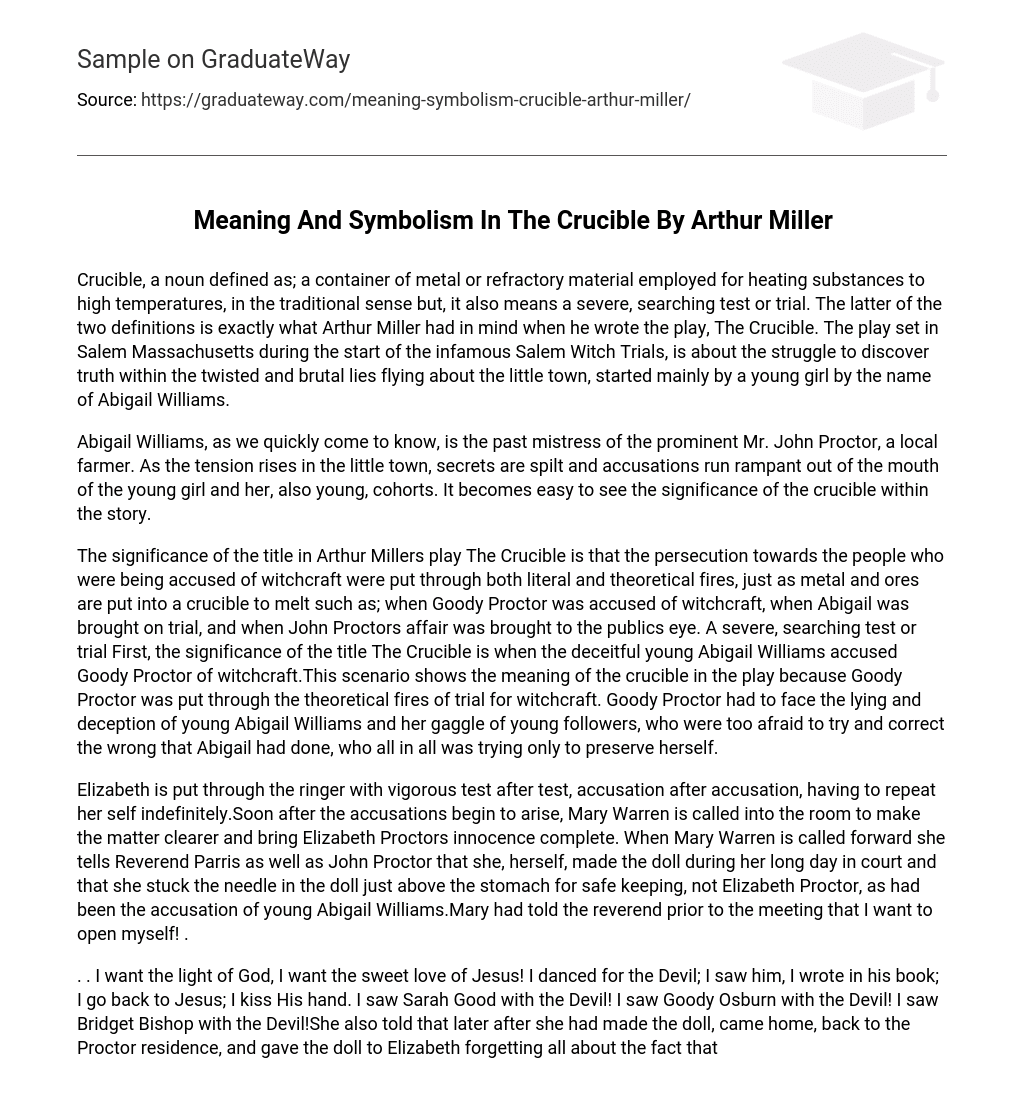The term “Crucible” has both a literal and metaphorical meaning. Literally, it refers to a container used for heating substances to high temperatures. Metaphorically, it represents a severe trial or test. Arthur Miller’s play, The Crucible, explores this latter meaning. Set in Salem Massachusetts during the notorious Salem Witch Trials, the story delves into the desperate search for truth amidst the rampant lies circulating in the town. These lies are primarily instigated by a young girl named Abigail Williams.
Abigail Williams is revealed to be the former lover of John Proctor, a well-known farmer in the community. As tensions escalate in the town, Abigail, along with other young girls, begins making accusations and revealing secrets. The crucible becomes a symbol of great importance in the story.
The title of Arthur Miller’s play The Crucible holds great significance as it represents the intense persecution faced by those accused of witchcraft. This persecution can be compared to the process of melting metal or ores in a crucible. Throughout the play, there are several instances where individuals are subjected to severe tests and trials, such as when Goody Proctor is accused of witchcraft, when Abigail is brought to trial, and when John Proctor’s affair is exposed to the public. An important example highlighting the meaning of the crucible in the play is when deceitful young Abigail Williams accuses Goody Proctor of witchcraft. This incident demonstrates how Goody Proctor is metaphorically put through the trial, facing the lies and deception of Abigail and her group of followers who are too fearful to correct her wrongdoings. Ultimately, their actions only serve to protect themselves.
Elizabeth is subjected to numerous tests and accusations, forcing her to repeatedly defend herself. As the accusations continue, Mary Warren is brought in to clarify the matter and prove Elizabeth’s innocence. When Mary Warren speaks up, she informs Reverend Parris and John Proctor that she was the one who made the doll during her time in court, not Elizabeth Proctor as alleged by Abigail Williams. Mary had previously expressed her desire to be honest before the meeting.
I desire the light of God and the love of Jesus. I have danced in the presence of the Devil, recorded my experience in his book, but now I return to Jesus and venerate Him. I witnessed Sarah Good, Goody Osburn, and Bridget Bishop in association with the Devil. Additionally, later on, after creating a doll and delivering it to Elizabeth at the Proctor residence, she unintentionally overlooked the needle she had inserted into the rag doll.
Abigail Williams and the other young girls were summoned to the court to clarify whether Mary Warren had indeed placed the needle in the doll or if Goody Proctor had bewitched the doll. When accused of lying, Abigail suddenly feigned terror, suggesting that Mary Warren’s specter lurked in the rafters like a crow, waiting to harm them. The girls appeared entranced by this idea. Goody Proctor faced a crucible during her witchcraft trial, where flames and heat were metaphorical but would ultimately lead to her betrayal and eventual demise.
Young Abigail Williams showed little respect for the boundaries of truthfulness. During her trial, she faced numerous accusations of lying and fabricating false allegations. The weight of the lives lost due to her testimony would forever haunt her.
When Abigail was brought before Mary Warren, she pretended to cry and express pain, but in her thoughts, she believed she was the only person acting correctly. Abigail inexplicably became a source of information for the judges and lawyers, leading to the conviction and execution of the accused individuals. She was solely focused on seeking revenge and reuniting with her beloved, John Proctor.
Abigail relentlessly attempted to possess John, striving to have his wife condemned. When she failed to obtain him, Abigail determined that no one else could either. Thus, she began accusing John Proctor of the very thing she herself was known for – witchcraft. In one instance, a speechless Mary Warren witnessed Abigail drinking blood from a chicken and cursing Goody Proctor in the woods. All of these occurrences were connected to Abigail Williams, who now had to endure her own crucible and devise a means of escape. Although Abigail narrowly evaded the severe repercussions of her crimes, the burden of guilt and anticipation loomed over her, leading to rumors of her engaging in prostitution in Boston.
Abigail’s crucible and punishment for all the problems and repercussions she had caused was to forever be alone and used.





